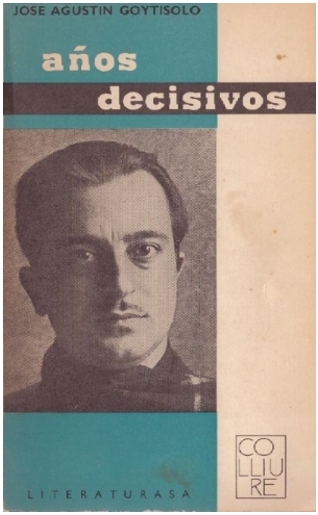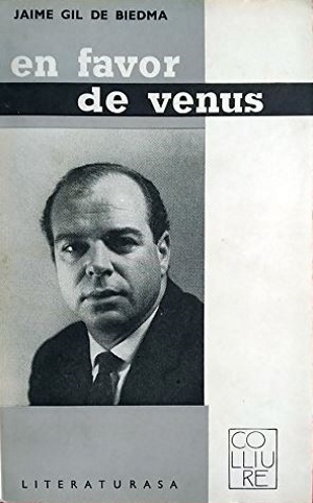Raúl Gimeno and Yolanda Ruiz
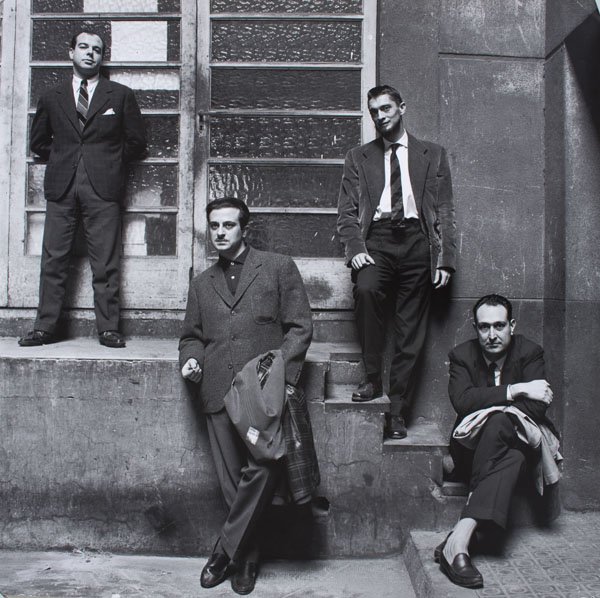
Until 12 January 2020, will be able the exhibition Oriol Maspons: Useful Photography / 1949-1995, which takes an extensive look at the photographer’s work. In the exhibition there is a photograph of the poets Jaime Gil de Biedma, José Agustín Goytisolo and Carlos Barral posing with the literary critic Josep Maria Castellet at the entrance to Industrias Gráficas Seix Barral (“the dark house in calle Provenza”, as Barral put it).
This photograph by Maspons in context
The men photographed formed the nucleus of the Group of Barcelona (known later as the School of Barcelona), part of the “Generation of the 50s”.
The Group of Barcelona, aware of the city’s isolation with respect to Madrid, the literary capital, decided to implement a generational strategy to make sure of a place on the literary map for themselves. Jaime Gil de Biedma, for example, in conversation with E. Sylvester (1979), said that, “Groups of poets are not generally a true historical fact, but a voluntary creation, more than anything an enterprise of ‘literary’ politics.” Later, with Jesús Fernández Palacios (1983), he admitted that, “at a given moment we decided to launch ourselves as a group, in an operation that was all about publicity, not literature.”
We believe there are five decisive moments of the promotional strategy to help the School of Barcelona to establish itself in the vanguard of Spanish poetry.
The five decisive moment of the promotional strategy of the School of Barcelona
1. The tribute to Antonio Machado
In February 1959 the Group of Barcelona took part in the tribute to Antonio Machado, held in Cotlliure, the town where the poet is buried.
In imitation of the tribute to Góngora and the later anthology of Gerardo Diego , who helped the baptism of the Generation of ‘27, the homage to Machado served as a generational baptism to this new promotion of writers that will be known as Generation of the 50

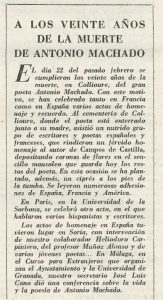
Among those in attendance, there were Blas de Otero, Caballero Bonald, Ángel González, José Ángel Valente, Gil de Biedma, José Agustín Goytisolo, Carlos Barral, Alfons Costafreda, Manolo Millares, Josep Guinovart and Joan Ferraté. Their names did not appear in the article to avoid possible reprisals.
Both Jaime Gil de Biedma and Carlos Barral stress, in their respective diaries, the tribute’s usefulness for publicity reasons. The former writes, “Returned yesterday from Colliure. The tribute discreet – moving even. The group was very good, interesting and fun. For us, moreover, a group affirmation.” (24/2/1959.) The latter confirms that, “the thing about the generational front is, nevertheless, great fun and not totally pointless, it would seem,” but he adds that literary politics is too demanding: “Since Colliure I’ve been spending all my time in generational politics. Interviews, common front, publications policy, anthology…, etc. So I’m not getting anything done. “Luna de agosto” is still unfinished.” (9/3/1959.)
This commemoration was reflected by José Agustín Goytisolo in the poem Homenaje en Collioure.
«Aquí, junto a la línia
divisoria, este día
veintidós de febrero,
yo no he venido para
llorar sobre tu muerte,
sinó que alzo mi vaso
y brindo por tu claro
camino, y por que siga
tu palabra encendida,
como una estrella, sobre
nosotros ¿nos recuerdas?,
Aquellos niños flacos,
tiznados, que jugaban
también a guerras, cuando,
grave y lúcido, ibas,
don Antonio, al encuentro
de esta tierra que yaces.»
“Homenaje en Collioure”, by José Agustín Goytisolo
2. The poetic conversations at the Formentor
From 18 to 25 May 1959 “Cela’s ‘Poetic Conversations’” (as Carlos Barral called them) were held at the Hotel Formentor in Mallorca. The text, virtually a declaration of intent, which announces, presents and describes these poetic conversations appeared in that year’s March issue of Papeles de Son Armadans: “The poets will come to the Conversations to talk and to have a drink in love and companionship. Wine – like the moon and impossible loves – is a good friend to verse. Here nobody is deceived. The Conversations are not intended to be anything more – or less, either – than what their name says: a private gathering in which that – and only that – which popular wisdom calls ‘our things’ will be talked about familiarly.”

The Group of Barcelona was present in those conversations thanks to Goytisolo’s friendship with Caballero Bonald and Camilo José Cela, subeditor and editor, respectively, of Papeles de Son Armadans.
Issue 151 of the journal Ínsula reported the meeting.

As Goytisolo did in Homenaje en Collioure, so did Jaime Gil de Biedma, using a collective experience as the theme for a poem. He writes in his diary: “I have been thinking, all these days, about the feasibility of ‘Conversaciones poéticas’, the poem about Formentor that I promised to write for Cela.” (23/7/1959.) The poem began with the group’s arrival at the poetic retreat organized by Cela.
«Predominaba un sentimiento
de general jubilación.
Abrazos,
inesperadas preguntas de amistad
y salutación
de algún maestro
‒borrosamente afín a su retrato
en la Antología de Gerardo Diego‒
nos recibieron al entrar.»
“Conversaciones poéticas”, by Jaime Gil de Biedma
3. The reading at the Ateneo de Madrid
As a result of the conversations at the Formentor, the members of the School of Barcelona established connections with other national and international poets. Through these, Goytisolo, Barral and Gil de Biedma were invited to read their poems at the Ateneo de Madrid, in the “Literary Thursdays” directed by José Hierro. This is what Jaime Gil de Biedma says about it in his diary the 29/10/1959.
A small article, appearing in issue 156 of the journal Ínsula, confirmed its success.
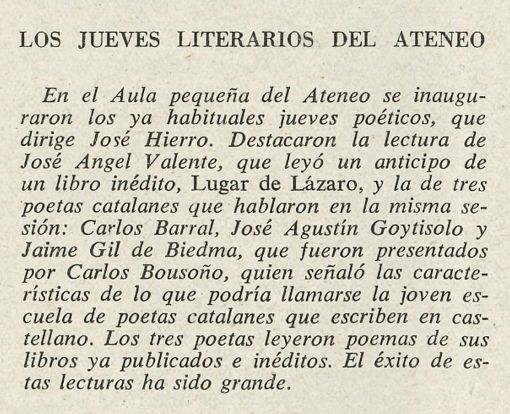
For the launch of the Barcelona group the reading in Madrid was very important, because it was the centre of the literary scene. But the reading was not the only promotional event of the week. On Sunday, All Saints Day, as Gil de Biedma writes in his diary, they took part in a “group expedition to the civilian cemetery in Madrid, to visit the tombs of Baroja and Pablo Iglesias.” Jaime Gil de Biedma’s poem Un día de difuntos recreates this expedition.
«Éramos unos cuantos
intelectuales, compañeros jóvenes,
los que aquella mañana lentamente avanzábamos
entre la multitud, camino de los cementerios.»
“Un día de difuntos” by Jaime Gil de Biedma
4. Josep Maria Castellet’s anthology
The Group of Barcelona’s consolidation came in 1960 with the appearance of Castellet’s anthology Veinte años de poesía española (Twenty Years of Spanish Poetry) and the creation of the Literaturasa publishing house’s Colliure collection.
The idea of putting together an anthology to promote the group went back a long way, from when the writers were contributing to the magazine Laye. In a letter of 28 September 1955, Jaime Gil de Biedma asks Carlos Barral about Laye’s project for an anthology: «What do you know about Laye anthology? Get back to me and, if it is already decided, tell me deadlines for delivery of originals and conditions». Later, Carlos Barral also refers in his memoirs to the stillborn Laye anthology, the precedent for Veinte años de poesía española: «The maneuver of the workshop for the writing of the anthology had to begin immediately, drastically, after years of hesitation before the project of what must have been Antología de Laye, a direct codification of the Barcelona group».
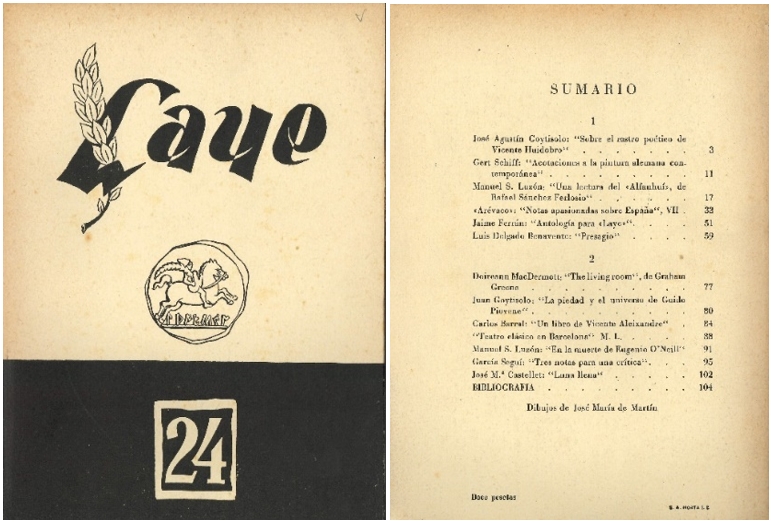
When the anthology Veinte años de poesía española eventually appeared in 1960, the journal Ínsula (no. 166, September 1960), and Destino (no. 1212, 29/10/1960) both mentioned it.
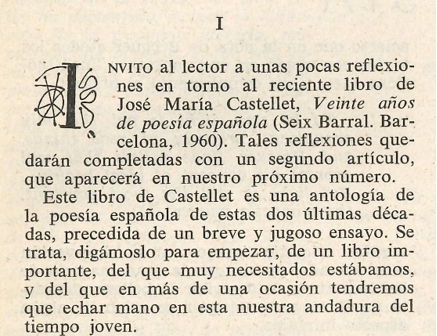
The initial dedication “To the memory of Antonio Machado, on the twentieth anniversary of his death” reveals Josep Maria Castellet’s interest in associating the anthology with the figure of Machado and with the commemorative events that were held in Cotlliure in 1959. In the critic’s opinion: “new poets are emerging, separately, who, in just a few short years, evolving in many cases in parallel fashion, acquire a certain common poetic conscience, which is expressed openly in public, because of the commemoration of the 20th anniversary of the death of Antonio Machado.”
Veinte años de poesía española was not well received in some quarters, but it fulfilled its objective: to make quite a big splash. Jaime Gil de Biedma says this in a letter to Caballero Bonald (15/11/1960): “If you remain in contact at all continuously with Spain, especially through literary journals, you will have already seen that there has been quite a commotion about José María Castellet’s anthology. I think it’s the best thing that could have happened to us.”
5. The creation of the Colliure collection
The collection was created in 1960, although the first books were not published until 1961, and it ended in 1966. The initial plan was to publish 12 books, by young authors mostly, along with some established poets, but in the end only eleven titles were published, including Años decisivos (1961) by José Agustín Goytisolo; Diecinueve figuras de mi historia civil (1961) by Carlos Barral, and En favor de Venus (1965) by Jaime Gil de Biedma.
Covers of the books by José Agustín Goytisolo, Carlos Barral and Jaime Gil de Biedma in the Colliure collection
For some critics, Colliure promoted above all the members of the School of Barcelona, the group of young Catalan poets that had been publicizing themselves for some time. In La Escuela de Barcelona, Carme Riera tells us about the foundation of the collection: “Colliure was founded in Barcelona in 1960 by José M.ª Castellet, as director; Carlos Barral, who thanks to Seix-Barral would provide printing and distribution; Jaime Gil de Biedma and José Agustín Goytisolo who would act as advisors, and Jaime Salinas, as editor. They all put in about 5,000 pesetas.”
So, the useful photograph by Oriol Maspons that gives the article its title immortalized the group at the heart of the School of Barcelona during their promotional strategy. The protagonists’ legacies and their importance in the literature of the second half of the 20th century bear witness to its success.
A photograph in context or the context of a photograph?

